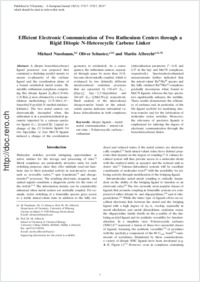Efficient electronic communication of two ruthenium centers through a rigid ditopic N-heterocyclic carbene linker
- Nussbaum, Michael Department of Chemistry, University of Fribourg, Switzerland
- Schuster, Oliver Department of Chemistry, University of Fribourg, Switzerland
- Albrecht, Martin Department of Chemistry, University of Fribourg, Switzerland - School of Chemistry & Chemical Biology, University College Dublin, Ireland
-
2013
Published in:
- Chemistry – A European Journal. - 2013, vol. 19, no. 51, p. 17517–17527
English
A ditopic benzobis(carbene) ligand precursor was prepared that contained a chelating pyridyl moiety to ensure co-planarity of the carbene ligand and the coordination plane of a bound octahedral metal center. Bimetallic ruthenium complexes comprising this ditopic ligand [L₄Ru-C,N-bbi-C,N-RuL₄] were obtained by a transmetalation methodology (C,N-bbi-C,N=benzobis(N-pyridyl-N′-methyl-imidazolylidene). The two metal centers are electronically decoupled when the ruthenium is in a pseudotetrahedral geometry imparted by a cymene spectator ligand (L₄=[(cym)Cl]). Ligand exchange of the Cl⁻/cymene ligands for two bipyridine or four MeCN ligands induced a change of the coordination geometry to octahedral. As a consequence, the ruthenium centers, separated through space by more than 10 Å, become electronically coupled, which is evidenced by two distinctly different metal-centered oxidation processes that are separated by 134 mV (L₄=[(bpy)₂]; bpy=2,2′-bipyridine) and 244 mV (L₄=[(MeCN)₄]), respectively. Hush analysis of the intervalence charge-transfer bands in the mixed-valent species indicates substantial valence delocalization in both complexes (delocalization parameter Γ=0.41 and 0.37 in the bpy and MeCN complexes, respectively). Spectroelectrochemical measurements further indicated that the mixed-valent RuII/RuIII species and the fully oxidized RuIII/RuIII complexes gradually decompose when bound to MeCN ligands, whereas the bpy spectators significantly enhance the stability. These results demonstrate the efficiency of carbenes and, in particular, of the bbi ligand scaffold for mediating electron transfer and for the fabrication of molecular redox switches. Moreover, the relevance of spectator ligands is emphasized for tailoring the degree of electronic communication through the benzobis(carbene) linker.
- Faculty
- Faculté des sciences et de médecine
- Department
- Département de Chimie
- Language
-
- English
- Classification
- Chemistry
- License
- License undefined
- Identifiers
-
- RERO DOC 209301
- DOI 10.1002/chem.201302688
- Persistent URL
- https://folia.unifr.ch/unifr/documents/303377
Other files
Statistics
Document views: 64
File downloads:
- nus_eec.pdf: 149
- nus_eec_sm.pdf: 84

